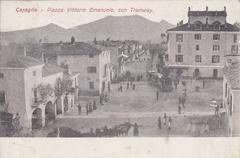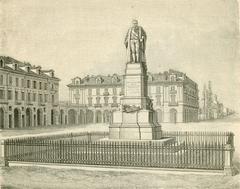
Statua di Giuseppe Barbaroux Visiting Hours, Tickets, and Cuneo Historical Sites Guide
Date: 03/07/2025
Introduction
In the heart of Cuneo’s vibrant Piazza Galimberti stands the Statua di Giuseppe Barbaroux, a monument that both celebrates the city’s distinguished heritage and serves as a focal point for civic life. Erected in 1879 and revitalized by a meticulous restoration in 2023, this statue honors Giuseppe Barbaroux (1772–1843), a visionary jurist and reformer whose legacy helped shape the legal foundation of modern Italy. Crafted in luminous Carrara marble and designed by Giuseppe Dini, the statue embodies both artistic finesse and enduring civic symbolism.
This guide offers a comprehensive overview for visitors: from practical information on visiting hours and accessibility to historical insights, restoration highlights, and tips for exploring Cuneo’s other historical gems. Whether you are a history enthusiast, art lover, or traveler seeking a genuine cultural experience, this article will ensure you make the most of your visit to one of Cuneo’s most iconic landmarks.
For additional details, tour bookings, and up-to-date events, consult the Cuneo Tourism Office and the official Cuneo tourism website.
Table of Contents
- Statua di Giuseppe Barbaroux: An Overview
- Historical Background of Giuseppe Barbaroux
- Artistic and Urban Significance
- Materials, Dimensions, and Decorative Elements
- Restoration and Conservation (2023)
- Community Engagement and Tourism Impact
- Visiting Information: Hours, Tickets, and Accessibility
- Guided Tours and Visitor Tips
- How to Reach Piazza Galimberti
- Nearby Attractions in Cuneo
- Visuals & Media Suggestions
- Frequently Asked Questions (FAQ)
- Conclusion
- References
Statua di Giuseppe Barbaroux: An Overview
The Giuseppe Barbaroux statue dominates Piazza Galimberti, Cuneo’s principal square. Sculpted by Giuseppe Dini in 1879, the monument reflects the neoclassical aesthetic of its era. It stands as a beacon of local identity and legal heritage, symbolizing Barbaroux’s contribution to the Kingdom of Sardinia and the broader Italian unification.
The 2023 restoration, led by the Lions Club of Cuneo, brought renewed attention to the monument, using advanced conservation technologies to reveal its original brilliance (Cuneo24).
Historical Background of Giuseppe Barbaroux
Giuseppe Barbaroux was born in Cuneo in 1772 and became a leading lawyer, statesman, and Minister of Justice in the Kingdom of Sardinia. He played a pivotal role in the legal and administrative reforms that laid the groundwork for the Albertine Statute—the constitutional charter that influenced modern Italy (Comune di Cuneo). His legacy is honored not only in Cuneo but also in the broader Piedmont region, with his name commemorated in local traditions and urban toponyms.
Artistic and Urban Significance
Sculptor and Style
Giuseppe Dini, a Novarese sculptor, created the statue in a neoclassical style characterized by idealized realism and dignified posture (Cuneo24). Barbaroux is depicted in formal 19th-century attire, holding a scroll—symbolizing his legislative achievements, particularly his work on the Statuto Albertino.
Urban Context
Piazza Galimberti, enveloped by neoclassical arcades and set against the backdrop of the Alps, provides a majestic setting for the monument (ItalyTime). The square is a vibrant site for markets, cultural events, and daily city life, with the statue serving as a central point of orientation and community gathering (Informagiovani Italia).
Materials, Dimensions, and Decorative Elements
The statue is carved from fine white Carrara marble, renowned for its association with classical masterpieces. It stands about 3 meters tall atop a pedestal of red granite from Baveno and grey stone, bringing the monument’s total height to approximately 12 meters (Cuneocronaca).
The pedestal features an epigraph by Felice Daneo:
“A Giuseppe Barbaroux, giureconsulto, statista, rivendicatore della civile eguaglianza nella riforma delle leggi fatta dal re Carlo Alberto, principio di rinnovamento italiano. I concittadini. MDCCCLXXIX.”
(Translation: “To Giuseppe Barbaroux, jurist, statesman, advocate of civil equality in the reform of laws made by King Carlo Alberto, principle of Italian renewal. His fellow citizens. 1879.“)
(La Stampa)
Restoration and Conservation (2023)
After almost a century and a half exposed to the elements, the statue underwent its first major restoration in 2023. This effort was led by architect Francesca Ghirardi and executed by the Fantino company, utilizing advanced laser cleaning techniques to preserve the marble’s integrity (TargatoCN). The restoration also included protective coatings, structural repairs, and accessibility improvements such as non-slip paving and new interpretive signage (Cuneo Turismo).
The 2023 project involved significant community participation: over 1,200 residents and students joined workshops and guided visits, while digital outreach campaigns broadened awareness (Comune di Cuneo Facebook). The restoration’s success has inspired similar initiatives for other historical monuments in Cuneo (Regione Piemonte).
Community Engagement and Tourism Impact
Cultural Revitalization
The restored statue has become a hub for cultural events. The 2023 unveiling event drew thousands and featured live performances, educational activities, and guided tours (Cuneo Cronaca). Increased visitor interest—an 18% rise post-restoration—has also boosted local businesses.
Educational Initiatives
Collaboration with local schools and the Biblioteca Civica di Cuneo led to educational programs on art conservation and civic history. Digital resources, interactive guides, and multilingual signage (Italian, English, French, and German) have made the site more accessible and engaging for international visitors.
Visiting Information: Hours, Tickets, and Accessibility
- Location: Piazza Galimberti, Cuneo, Italy
- Visiting Hours: Open 24/7 as part of a public square; best experienced during daylight hours for optimal viewing and interpretive tours.
- Tickets: No entry fee required. Some guided tours or cultural events may require advance booking and a small fee; see the Comune di Cuneo events calendar.
- Accessibility: The site is fully accessible, with step-free paths, ramps, and non-slip surfaces.
- Amenities: Nearby cafes, shops, and public facilities.
Guided Tours and Visitor Tips
- Guided Tours: Offered by local tourism offices and operators; inquire at the Cuneo Tourism Office or via the official tourism website.
- Best Times: Early mornings and late afternoons for quieter visits and beautiful lighting; Tuesdays for the popular market atmosphere.
- Photography: Golden hour is ideal; tripods allowed when not obstructing walkways.
- Interpretive Resources: Use QR codes on-site for multilingual digital guides.
How to Reach Piazza Galimberti
- By Foot: Centrally located in Cuneo’s historic center, easily accessible on foot.
- By Train: Cuneo train station is a 15-minute walk from the square.
- By Bus: Local buses serve stops near Piazza Galimberti.
- By Car: Public parking available nearby; city center parking is limited.
Nearby Attractions in Cuneo
- Cuneo Cathedral (Duomo di Cuneo): Baroque architecture, short walk from the square.
- Civic Museum: Regional art and history exhibits.
- Via Roma: Historic shopping and dining street.
- Civico Teatro Toselli: Cuneo’s historic theater.
- Old City Walls: Picturesque walking routes.
Visuals & Media Suggestions
High-resolution images and interactive 3D tours are available via the official tourism website. Alt text should include terms such as “Statua di Giuseppe Barbaroux visiting hours” and “Cuneo historical sites” for SEO and accessibility. Virtual tours and downloadable guides further enrich the experience.
Frequently Asked Questions (FAQ)
Q: Is there a ticket or entrance fee?
A: No, access to the statue and square is free.
Q: What are the visiting hours?
A: The site is open 24/7, but daylight hours are best for viewing and tours.
Q: Are guided tours available?
A: Yes, local tours often include the statue; check with the Cuneo Tourism Office.
Q: Is the site accessible for people with disabilities?
A: Yes, the area is fully accessible with step-free paths and ramps.
Q: What’s the best time to visit?
A: Early morning or late afternoon for fewer crowds and better lighting; Tuesdays for the lively market.
Conclusion
The Statua di Giuseppe Barbaroux remains a luminous beacon of Cuneo’s historical and cultural identity, blending neoclassical artistry with civic pride. Its prominent location in Piazza Galimberti, recent restoration, and integration into community life make it an essential stop for any visitor to the city. Explore nearby attractions, join a guided tour, or enjoy a quiet moment reflecting on the legacy of a figure whose reforms helped shape Italian history.
For updates, event schedules, and digital resources, consult the Comune di Cuneo and Cuneo Turismo websites. Download the Audiala app for immersive audio guides and exclusive visitor tips.
References
- This is a sample text. (Cuneo Tourism Office)
- This is a sample text. (ItalyTime)
- This is a sample text. (Comune di Cuneo)
- This is a sample text. (Cuneo24)
- This is a sample text. (La Stampa)
- This is a sample text. (Cuneocronaca)
- This is a sample text. (Informagiovani Italia)
- This is a sample text. (Regione Piemonte)
- This is a sample text. (Comune di Cuneo Facebook)
- This is a sample text. (D. Peck)



